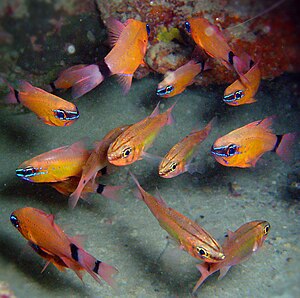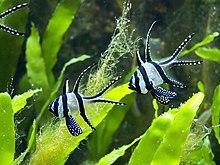Cardinalfish
| Cardinalfish | ||||||||||||
|---|---|---|---|---|---|---|---|---|---|---|---|---|

Sun cardinalfish ( Ostorhinchus aureus ) and an undetermined species of cardinalfish in a cave on Ningaloo Reef |
||||||||||||
| Systematics | ||||||||||||
|
||||||||||||
| Scientific name | ||||||||||||
| Apogonidae | ||||||||||||
| Bonaparte , 1846 |
The family of the cardinalfish (Apogonidae) belongs to the perch relatives (Percomorphaceae) and comprises over 25 genera with around 350 species . The family has a worldwide distribution in tropical and subtropical seas, mostly in rocky or coral reefs , a few also in brackish water , the nine species of the genus Glossamia only in fresh waters of Australia and New Guinea . The coral reef inhabitants prefer the protected inner reefs and avoid the steep outer reefs . The red mullet king ( Apogon imberbis ) lives in the Mediterranean . Only recently have Apogonichthyoides nigripinnis and Apogonichthyoides taeniatus immigrated through the Suez Canal into the Mediterranean.
features
Cardinalfish are small, 3 to 25 centimeters long and often reddish colored fish. Most species stay smaller than 10 centimeters. Their mouth is protractile (can be pushed forward) and slightly above , the eyes are large in adaptation to the main activity time in the twilight or at night. The two dorsal fins are clearly separated. The scales are usually ctenoid ( comb scales ), in some groups cycloid ( round scales ). The genus Gymnapogon has no scales. The species of the genus Siphamia have luminous organs located on the abdomen .
Fin formula : dorsal VI – VIII / 8–14, anal II / 8–18
Way of life
Cardinalfish are mainly crepuscular or nocturnal schooling fish and hide during the day between hard corals , in caves or crevices. Almost all cardinalfish feed on zooplankton , some species, such as the sea cardinalfish ( Cheilodipterus artus ), also eat larger prey such as small fish. All male species are likely to be mouthbrooders .
External system

The family of the cardinalfish was originally placed in the order of the perch-like (Perciformes), a collective group which in its original composition was only insufficiently defined by derived characteristics and was certainly not monophyletic .
Comparative DNA sequence analyzes showed a relatively close relationship with the gobies (Gobioidei) and curter (Kurtidae), so that Christine Thacker and colleagues assigned the cardinalfish to the order of the Gobiiformes and the glass or hatchetfish (Pempheridae) as the sister group of the cardinalfish. Ricardo Betancur-R. and employees, on the other hand, set up a new order, the kurtiformes, in which cardinalfish and kurter are united as sister families (each with their own subordination). The Kurtiformes are the sister group of the Gobiiformes and together with them form the Gobiaria series. These relationships are confirmed by Thomas Near and colleagues in their study of the phylogeny of the Acanthomorpha based on DNA sequence analyzes , but cannot be supported by Fraser in his study of the relationship between cardinalfish and curter based on morphological comparisons.
Internal system
There are four subfamilies, over 25 genera and nearly 360 species. The Apogoninae , the largest subfamily, are divided into 14 tribes .
The following cladogram shows the relationships between the subfamilies and the tribe:

| Apogonidae |
|
|||||||||||||||||||||||||||||||||||||||||||||||||||
|
|
The position of the subfamily Paxtoninae and the tribe Lepidamiini (subfamily Apogoninae) has not yet been researched.
Fossil record
Fossil representatives of the cardinalfish are known from the middle Eocene of the northern Italian Monte Bolca Formation, which was formed from deposits of the Tethys . Eosphaeramia margaritae was high-backed and resembles the recent genus Sphaeramia , Apogon spinosus belongs to a genus that still exists today. Both fish were about 4 cm long.
Aquarium keeping
Some species, such as the Banggai cardinalfish ( Pterapogon kauderni ), the pajama cardinalfish ( Sphaeramia nemanoptera ) and the threadfin cardinalfish ( Zoramia leptacantha ), are popular ornamental fish in marine aquariums . The aquarium should be set up with caves and shelters to mimic their natural biotope. Most cardinalfish only eat live and frozen food . They are not expected to attack sessile invertebrates.
Cardinalfish are very sensitive to transport and die in large numbers at the dealer or in the home aquarium. Pterapogon kauderni can also be bred.
swell
literature
- Gerald R. Allen : Cardinalfishes. In: KE Carpenter, VH Niem: FAO species identification guide for fishery purposes. The living marine resources of the Western Central Pacific. Vol. 1: Seaweeds, corals, bivalves and gastropods. 1998, ISBN 92-5-104051-6 .
- Hans A. Baensch , Robert Patzner: Mergus sea water atlas. Volume 7: Perciformes (perch-like). Mergus-Verlag, Melle 1998, ISBN 3-88244-107-0 .
- Kurt Fiedler: Textbook of Special Zoology. Volume II, Part 2: Fish . Gustav Fischer Verlag, Jena 1991, ISBN 3-334-00339-6 .
- Rudie H. Kuiter , Helmut Debelius : Atlas of the marine fish. Kosmos-Verlag, 2006, ISBN 3-440-09562-2 .
- Ewald Lieske, Robert F. Myers: Coral fish of the world. Jahr Verlag, Hamburg 1994, ISBN 3-86132-112-2 .
- Joseph S. Nelson : Fishes of the World. John Wiley & Sons, 2006, ISBN 0-471-25031-7 .
Individual evidence
- ↑ Apogonichthyoides nigripinnis on Fishbase.org (English)
- ↑ Apogonichthyoides taeniatus on Fishbase.org (English)
- ↑ Christine E. Thacker, Dawn M. Roje: Phylogeny of cardinalfishes (Teleostei: Gobiiformes: Apogonidae) and the evolution of visceral bioluminescence. Molecular Phylogenetics and Evolution, Volume 52, Issue 3, September 2009, pp. 735-745. doi: 10.1016 / j.ympev.2009.05.017
-
↑
Ricardo Betancur-R., Richard E. Broughton, Edward O. Wiley et al: The Tree of Life and a New Classification of Bony Fishes. In: PLOS Currents Tree of Life. 18th Apr 2013. [last modified: 2013 Apr 23]. Edition 1. doi: 10.1371 / currents.tol.53ba26640df0ccaee75bb165c8c26288 , PDF ( Memento of the original from October 13, 2013 in the Internet Archive ) Info: The archive link was inserted automatically and has not yet been checked. Please check the original and archive link according to the instructions and then remove this notice. R. Betancur-R, E. Wiley, N. Bailly, M. Miya, G. Lecointre, G. Ortí: Phylogenetic Classification of Bony Fishes. 2014, Version 3 ( Archived copy ( Memento of the original from August 14, 2015 in the Internet Archive ) Info: The archive link was automatically inserted and not yet checked. Please check the original and archive link according to the instructions and then remove this note. ).
- ↑ Thomas J. Near, A. Dornburg, RI Eytan, BP Keck, WL Smith, KL Kuhn, JA Moore, SA Price, FT Burbrink, M. Friedman, PC Wainwright: Phylogeny and tempo of diversification in the superradiation of spiny-rayed fishes. In: Proceedings of the National Academy of Sciences of the United States of America. 101, 2013, pp. 12738-21743. doi: 10.1073 / pnas.1304661110
- ^ TH Fraser: A new genus of cardinalfish (Apogonidae: Percomorpha), redescription of Archamia and resemblances and relationships with Kurtus (Kurtidae: Percomorpha). In: Zootaxa . 3714 (1), 2013, pp. 1-63. doi: 10.11646 / zootaxa.3714.1.1
- ↑ K. Mabuchi, TH Fraser, H. Song, Y. Azuma, M. Nishida: Revision of the systematics of the cardinalfishes (Percomorpha: Apogonidae) based on molecular analyzes and comparative reevaluation of morphological characters . In: Zootaxa. 3846 (2), 2014, pp. 151-203. doi: 10.11646 / zootaxa.3846.2.1
- ^ Karl Albert Frickhinger: Fossil Atlas of Fishes. Mergus-Verlag, Melle, 1999, ISBN 3-88244-018-X .
Web links
- Cardinalfish on Fishbase.org (English)

